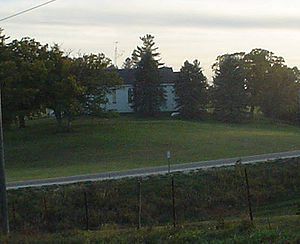.gif)
Saint Joseph's Prairie Church (Washington Township)
Encyclopedia

Catholic
The word catholic comes from the Greek phrase , meaning "on the whole," "according to the whole" or "in general", and is a combination of the Greek words meaning "about" and meaning "whole"...
parish of the Archdiocese of Dubuque. The parish was located in Washington Township, Dubuque County, Iowa
Dubuque County, Iowa
Dubuque County is a county located in the U.S. state of Iowa. The population was 93,653 in the 2010 census, an increase from 89,143 in the 2000 census. The county seat is the city of Dubuque. Dubuque County is coterminous with the Dubuque, Iowa Metropolitan Statistical Area, and is the seventh...
- which is about ten miles south of Dubuque, Iowa
Dubuque, Iowa
Dubuque is a city in and the county seat of Dubuque County, Iowa, United States, located along the Mississippi River. In 2010 its population was 57,637, making it the ninth-largest city in the state and the county's population was 93,653....
.
In 1843, Father T.J. Donaghoe and five Sisters of Charity of the Blessed Virgin Mary (B.V.M.) were invited to move to the Dubuque area by Bishop Mathias Loras. They moved from Philadelphia, Pennsylvania
Philadelphia, Pennsylvania
Philadelphia is the largest city in the Commonwealth of Pennsylvania and the county seat of Philadelphia County, with which it is coterminous. The city is located in the Northeastern United States along the Delaware and Schuylkill rivers. It is the fifth-most-populous city in the United States,...
to a wooded area in nearby Table Mound Township. A chapel and a convent were built on the land. The Sisters remained in the area until their original convent was destroyed by fire. At that point the Sisters moved north to Dubuque
Dubuque, Iowa
Dubuque is a city in and the county seat of Dubuque County, Iowa, United States, located along the Mississippi River. In 2010 its population was 57,637, making it the ninth-largest city in the state and the county's population was 93,653....
.
After the death of Fr. Donaghoe in 1869, Bishop Hennessy of Dubuque sent Father Monaghan to establish the St. Joseph's Prairie parish. Matthew Powers, who was an area farmer, donated land for the church and cemetery. The church was built by 1875 for $4,000. A bell was added to the church, it had the distinction of being the largest bell in the Archdiocese of Dubuque. The bell weighed 5,247 pounds. For many years the bell stood in a tower at the north side of the church building. Eventually the bell was placed on a concrete platform on the church grounds. In 1894 the rectory was built for $1,500.
One of the more famous pastors of St. Joseph's was Raymond Ettledorf
Raymond Ettledorf
Raymond Philip Etteldorf was an Archbishop of the Roman Catholic Church. Ettledorf was born in the Winneshiek County, Iowa community of Ossian, and was ordained as a priest of the Archdiocese of Dubuque on December 8, 1937....
, who as an Archbishop served Apostolic Delegate to New Zealand, as a pro-Nuncio to Ethiopia
Ethiopia
Ethiopia , officially known as the Federal Democratic Republic of Ethiopia, is a country located in the Horn of Africa. It is the second-most populous nation in Africa, with over 82 million inhabitants, and the tenth-largest by area, occupying 1,100,000 km2...
, and as an Official of State at the Vatican
Vatican City
Vatican City , or Vatican City State, in Italian officially Stato della Città del Vaticano , which translates literally as State of the City of the Vatican, is a landlocked sovereign city-state whose territory consists of a walled enclave within the city of Rome, Italy. It has an area of...
.
In 1952, nearby Holy Family
Holy Family Catholic Church (New Melleray)
Holy Family Catholic Church is a parish in the Archdiocese of Dubuque. It is located about ten miles south of Dubuque, Iowa. For many years, the monks of New Melleray Abbey provided care and support for the parish.-Early history:...
parish had been put under the supervision of the Archdiocese after having been the responsibility of the New Melleray Abbey
New Melleray Abbey
New Melleray Abbey is located near Dubuque, Iowa. The monks there are members of the Order of Cistercians of the Strict Observance . The abbey is located about 15 miles southwest of Dubuque and is located in the Archdiocese of Dubuque. The current Abbot is the Right Reverend Brendan...
for many years. St. Joseph's Prairie and Holy Family were affiliated, and shared pastors from then until the closing of the parish.
In 1989, it was decided to place the parish on oratory status
Oratory status
In the Roman Catholic Church, Oratory Status is a special status that a church building may be placed in. In oratory status the parish has been closed and the church building and grounds become the responsibility of a neighboring parish....
. The rectory was sold at this point. Most of the families were transferred over to Holy Family parish. The parish still owned the church building and grounds. For the next five years regular Sunday masses were not celebrated at the church, but the church building could still be used on special occasions - such as weddings and funerals. In 1994, it was finally decided to permanently close the parish. One last mass was held at the old church building.
A decree was issued relegating the church to Profane Use
Profane use
Profane use is a term used in the Roman Catholic Church to refer to closed parish churches that will no longer be used as churches. This is often done in preparation to sell the former church building to another party...
- or that it was no longer a church building. The building was sold to the family that had purchased the rectory. The building has since been converted into a storage shed. The bell has since been moved from its location just north of the church south to the church cemetery.

